Getting Started
Understanding what your competitors are doing to succeed in search engines is no longer a strategic advantage; it's a foundational requirement for digital growth. Simply creating content and hoping it ranks is an inefficient approach. To gain a competitive edge, you need to dissect your rivals' strategies: which keywords are driving their traffic, what backlinks are boosting their authority, and which content formats are resonating with their audience. This process, known as SEO competitor analysis, is the key to uncovering opportunities and avoiding costly mistakes.
The challenge lies in gathering this intelligence accurately and efficiently. Manually tracking competitor rankings, backlinks, and content performance is an impossible task. This is where specialized seo competitor analysis tools become indispensable. They automate the data collection process, providing you with actionable insights to inform your keyword targeting, link-building outreach, and content creation efforts. Before diving into specific platforms, understanding the importance of identifying and monitoring competitors' keyword performance is essential. You can learn more about specialized tools for niche keyword rank tracking to build a solid foundation.
This comprehensive guide moves beyond surface-level descriptions to provide a detailed breakdown of the top platforms available. We will analyze the core strengths and practical limitations of each tool, from all-in-one suites like Semrush and Ahrefs to specialized solutions like SpyFu and Majestic. You will learn not just what these tools do, but how to apply their features to specific use cases, whether you are a small business owner, an agency consultant, or an in-house marketing manager. Our goal is to equip you with the knowledge to select the right toolset that aligns with your specific budget, team size, and strategic objectives, helping you turn competitor data into measurable SEO success.
1. That's Rank
That's Rank earns its top spot by simplifying a critical aspect of SEO: daily rank tracking. While many all-in-one SEO platforms can feel overwhelming, That's Rank focuses on doing one thing exceptionally well. Its core strength lies in providing clear, daily-updated keyword positions for both your site and your competitors. This focus makes it an ideal starting point for businesses new to SEO or agencies needing a streamlined way to monitor multiple client campaigns without a steep learning curve or excessive cost.

The platform's design philosophy prioritizes clarity and actionability. Instead of burying you in data, its unified dashboard visually represents performance trends, making it easy to spot when a competitor outranks you for a target keyword. This immediacy allows for rapid strategy adjustments, a key component of effective SEO competitor analysis tools.
Key Features & Use Cases
- Competitor Rank Monitoring: The most practical feature is adding competitor domains to track their performance on your keyword list. A common use case is setting up alerts for when a rival enters the top 10 for a high-value keyword, signaling a need to analyze their content and backlink strategy.
- Unlimited Domain Support: For agencies or businesses with multiple websites, the Pro plan's unlimited domain tracking is a significant advantage. You can manage a diverse portfolio from a single dashboard, a feature often found only in much more expensive tools.
- Website Health Audits: While primarily a rank tracker, its simple SEO audit provides actionable recommendations. This is perfect for small business owners who need quick, easy-to-understand guidance on fixing on-page issues without technical jargon.
- White-Label Reporting: Agencies can generate clean, professional-looking reports for clients, directly from the platform, which streamlines communication and demonstrates value.
Pricing & Implementation
Getting started is straightforward. You simply create an account, add your domain, and input the keywords you want to track. The free plan is a great way to test the interface, but its three-keyword limit is restrictive. The real value is in the paid tiers.
- Free Plan: $0/month for 1 domain and 3 keywords.
- Pro Plan: $29/month for unlimited domains and up to 500 keywords.
Pros & Cons
Pros:
- Daily, accurate Google keyword ranking updates.
- Unlimited domain tracking on the Pro plan is exceptional value for agencies.
- Extremely user-friendly interface requires no technical expertise.
- Free plan available for basic testing.
Cons:
- The free plan is too limited for any serious analysis.
- Lacks the deep, all-in-one functionality (like backlink analysis or content ideation) of larger platforms like Ahrefs or Semrush.
Website: https://www.thatisrank.com
2. SEMrush
SEMrush is a true titan in the digital marketing world, evolving from a keyword research tool into a comprehensive, all-in-one suite. It excels at providing a 360-degree view of your competitor’s online strategy, making it one of the most powerful SEO competitor analysis tools available. Its massive database, featuring trillions of backlinks and billions of keywords, allows you to deconstruct nearly every aspect of a rival’s digital footprint, from their top-performing organic content to their paid ad campaigns.

While its breadth of features can seem daunting, the platform’s core strength lies in connecting disparate data points. You can identify a competitor's top organic keywords in the "Organic Research" tool, then pivot to the "Advertising Research" tool to see if they are also bidding on those terms via PPC. This integrated approach helps you uncover the full scope of a competitor's strategy and identify exploitable gaps.
Key Features & Use Cases
- Keyword Gap Analysis: This feature is a goldmine for competitive analysis. You can enter your domain alongside up to four competitors to instantly find keywords they rank for that you don't. This is perfect for discovering new content opportunities and expanding your SEO footprint.
- Advertising Research: Go beyond SEO by dissecting a competitor's paid search strategy. You can view their live ad copy, analyze their PPC keywords, and estimate their ad spend. This is invaluable for informing your own paid campaigns and understanding your rival's budget allocation.
- Backlink Analytics: A common use case is running a competitor's domain through the Backlink Analytics tool to find their high-authority referring domains. You can then use this list for your own outreach campaigns to acquire similar powerful links.
- Traffic Analytics: This tool provides estimates of a competitor's website traffic, including their primary sources (Direct, Referral, Search, Social, Paid). It helps you benchmark your own performance and understand which channels drive the most engagement for others in your niche. You can learn more about SEMrush's competitive analysis capabilities for a deeper dive.
Pricing & Implementation
SEMrush operates on a subscription model with tiered pricing based on feature access and data limits. Getting started involves creating an account and setting up a "Project" for your domain, which unlocks site audits and position tracking.
- Pro Plan: $129.95/month. Good for freelancers and small businesses.
- Guru Plan: $249.95/month. Adds historical data and content marketing features.
- Business Plan: $499.95/month. For agencies and large enterprises needing more extensive limits and API access.
Pros & Cons
Pros:
- Vast and frequently updated database for keyword and backlink analysis.
- Comprehensive suite covering SEO, PPC, content, and social media.
- Powerful "Gap Analysis" tools for keywords and backlinks are best-in-class.
- User-friendly interface despite its complexity.
Cons:
- The premium pricing can be a significant investment for startups or small businesses.
- The sheer number of tools and reports presents a steep learning curve for new users.
Website: https://www.semrush.com/
3. Ahrefs
Ahrefs is a powerhouse in the SEO industry, renowned for having one of the most comprehensive and rapidly updated backlink indexes available. While it has evolved into an all-in-one suite, its core strength remains in deconstructing a competitor's off-page strategy. For SEO professionals, Ahrefs is often the go-to platform for answering the critical question: "Why is my competitor outranking me?" The answer frequently lies in the quality and quantity of their backlinks, and Ahrefs provides the clearest possible view of that data.

The platform's "Site Explorer" is the central hub for competitive intelligence, merging backlink, organic keyword, and paid search data into a single, cohesive dashboard. This integration makes it one of the most effective seo competitor analysis tools because it allows you to see the full picture of a rival's digital footprint. You can identify their most valuable pages, the keywords they rank for, and the websites linking to them, providing a direct roadmap for your own strategy. Learn more about how to leverage Ahrefs for rank tracking.
Key Features & Use Cases
- Site Explorer: The cornerstone feature. A common use case is to enter a competitor's domain and navigate to the "Best by links" report. This instantly shows which of their pages have attracted the most backlinks, revealing content formats and topics that are proven to work in your niche.
- Keywords Explorer: Beyond simple volume and difficulty, this tool helps you find "keyword gaps." You can input your domain and up to four competitors to see which valuable keywords they rank for that you don't, providing immediate content opportunities.
- Content Explorer: This functions like a search engine for top-performing content. A practical application is searching for a broad topic and filtering by "referring domains" to find content that has earned a high number of links but has become outdated, creating an opportunity for a "Skyscraper" content update.
- Rank Tracker: A robust tool for monitoring keyword positions over time against competitors. It allows for tagging keywords and viewing historical performance graphs to pinpoint when and why ranking shifts occurred.
Pricing & Implementation
Ahrefs is a premium tool with pricing that reflects its extensive data and feature set. There is no longer a free trial or plan, so new users must commit to a paid subscription. Implementation is web-based and requires no installation; you simply sign up and begin entering domains or keywords to analyze.
- Lite: $99/month for 1 user and limited project/keyword tracking.
- Standard: $199/month with more generous limits, ideal for small businesses and freelancers.
- Advanced: $399/month for multiple users and extensive data access, suited for agencies.
- Enterprise: $999/month for large-scale agency and enterprise needs.
Pros & Cons
Pros:
- Best-in-class backlink index with incredibly fresh data.
- User-friendly interface that presents complex data in an understandable way.
- Excellent integration between tools (e.g., finding a keyword gap and sending it directly to the rank tracker).
- Powerful content and keyword research features that go beyond basic metrics.
Cons:
- High price point makes it inaccessible for some small businesses or beginners.
- The credit-based system on newer plans can be confusing and lead to unexpected costs.
- Removal of the free trial and Lite plan restrictions can be a barrier to entry.
4. Moz Pro
Moz Pro has long been a staple in the SEO world, earning its place by making complex SEO concepts accessible to a broader audience. It’s particularly well-known for creating the "Domain Authority" (DA) metric, a widely used benchmark for estimating a website's ranking potential. This makes it an excellent choice for marketers and business owners who need a reliable, all-in-one suite to understand not just their own site's health, but where they stand relative to their competition in a clear, quantifiable way.
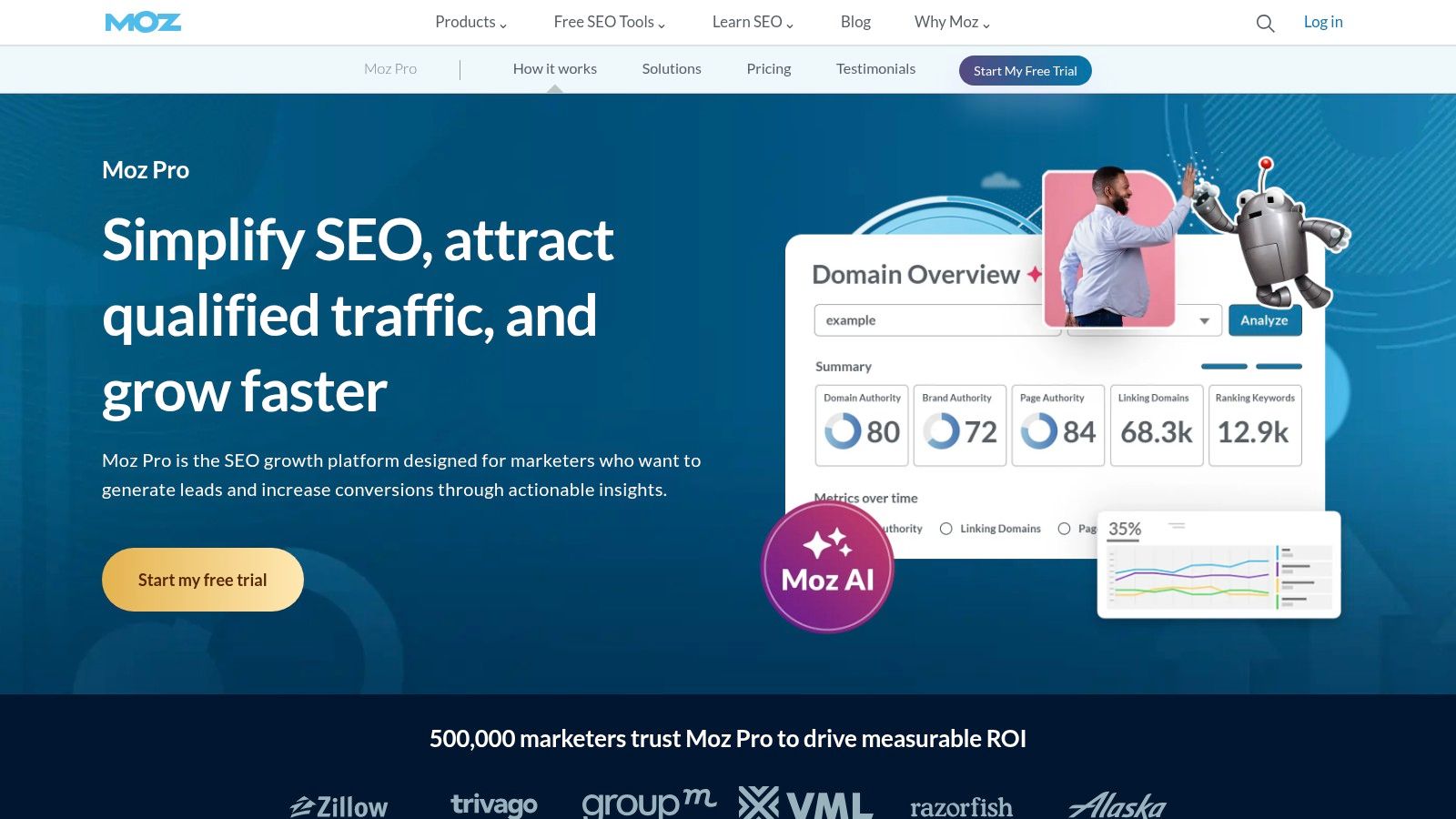
The platform blends a comprehensive feature set with an intuitive interface, striking a balance between depth and usability. While other platforms might offer more granular data, Moz excels at presenting actionable insights. Its tools are designed to work together, allowing you to move seamlessly from identifying a competitor's high-ranking keyword to analyzing the backlinks that support it, making it a strong contender among SEO competitor analysis tools.
Key Features & Use Cases
- Link Explorer: A core feature for competitive analysis. You can enter a competitor's URL to see their backlink profile, Domain Authority, and top-linked pages. A practical use case is to identify high-authority sites linking to multiple competitors but not to you, revealing prime outreach opportunities.
- Keyword Explorer: Helps you discover and prioritize keywords. You can analyze a competitor's domain to see which keywords they rank for, then use the "Difficulty" and "Organic CTR" scores to find strategic gaps in their strategy.
- On-Page Grader: After identifying a competitor's successful page, you can run your equivalent page through the grader. It provides a simple optimization score and a checklist of improvements to help you better compete.
- Site Crawl: Identifies technical SEO issues on your site. While not strictly a competitive tool, fixing your own site's crawl errors is a crucial first step before attempting to outrank established rivals.
Pricing & Implementation
Setting up Moz Pro involves connecting your Google Analytics and creating a "Campaign" for your domain. You then add competitors and keywords to track. While there is a free 30-day trial, the toolset is best leveraged through its paid plans.
- Standard: $99/month for basic tools and limited campaign tracking.
- Medium: $179/month, the most popular plan, offering more keywords, reports, and full access to Keyword Explorer.
- Large: $299/month for larger agencies and businesses.
Pros & Cons
Pros:
- Very intuitive and user-friendly interface, great for beginners.
- Domain Authority is a simple, effective metric for quick competitor comparisons.
- Strong community support and extensive educational resources (like the Whiteboard Friday series).
Cons:
- Backlink and keyword data indexes can be smaller than competitors like Ahrefs or Semrush.
- Higher-tier plans can be costly for small businesses or freelancers.
Website: https://moz.com/products/pro
5. SpyFu
SpyFu carves out its niche by focusing almost exclusively on competitive intelligence, making it one of the most direct SEO competitor analysis tools available. Its core premise is simple yet powerful: enter any competitor’s domain, and instantly uncover their entire search marketing playbook. The platform excels at revealing the organic keywords a rival ranks for and, crucially, the paid keywords they are bidding on in Google Ads. This makes it invaluable for businesses looking to reverse-engineer successful strategies without paying for expensive trial-and-error campaigns.
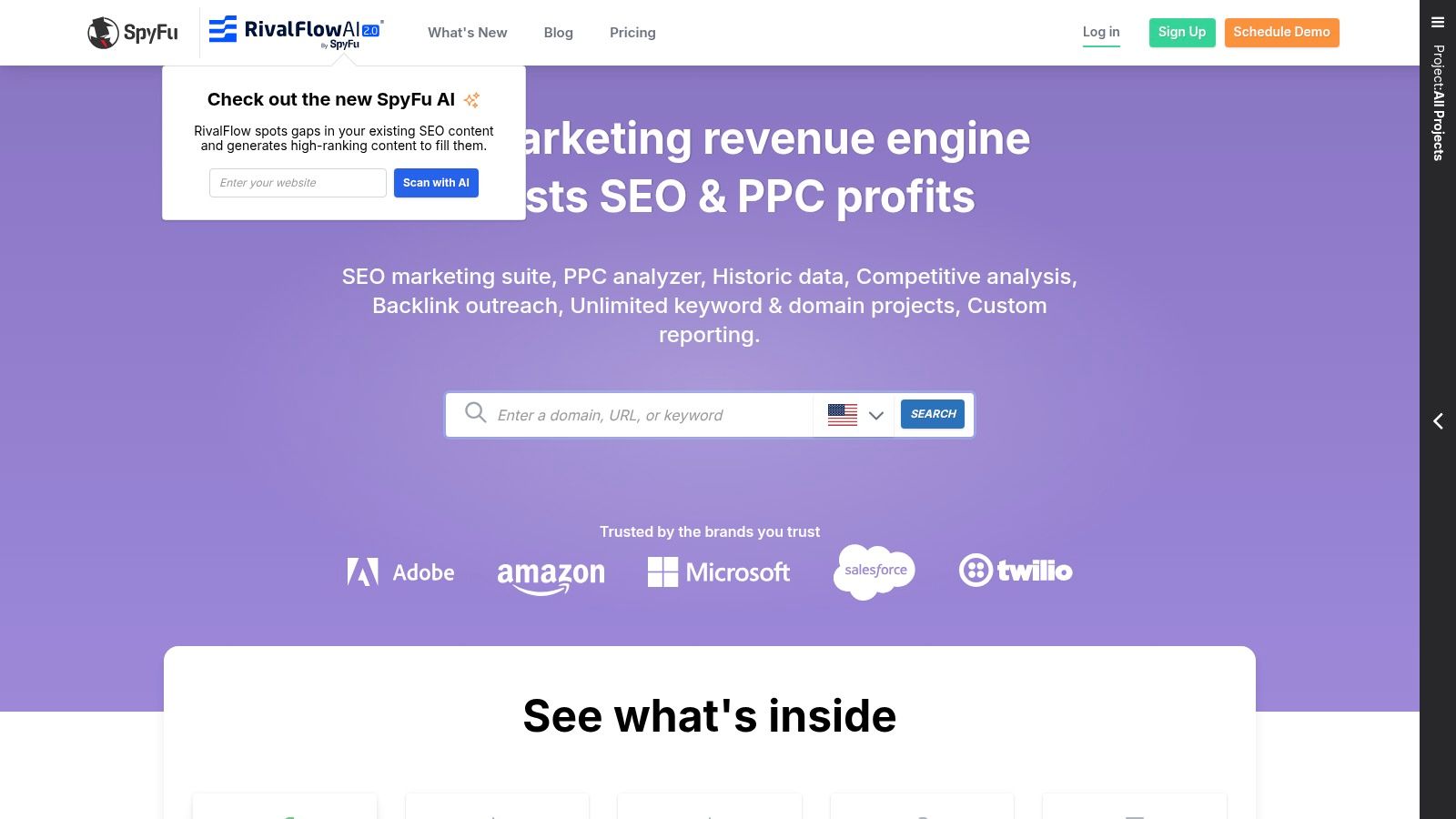
The platform is designed for action, presenting historical data that shows how a competitor's keyword focus and ad spend have evolved. This historical perspective is a key differentiator, allowing you to see which keywords have been consistently profitable for them over time. By identifying these long-term winners, you can prioritize your own SEO and PPC efforts with a higher degree of confidence.
Key Features & Use Cases
- Competitor Keyword Analysis: Its "Kombat" feature allows you to see the keyword universe of up to three domains side-by-side. A common use case is identifying "Keywords Your Competitors Rank For (But You Don't)," providing an immediate, actionable list of content gaps to fill.
- PPC Research: SpyFu provides deep insights into a competitor’s Google Ads campaigns. You can see their ad copy, estimated monthly budget, and the keywords they bid on. This is perfect for a new advertiser wanting to learn from established players before spending their own budget.
- Ranking History: The tool charts a domain’s ranking history for specific keywords over many years. This helps you determine if a competitor’s high ranking is a recent fluke or a long-held position, informing the level of effort required to unseat them.
- Backlink Outreach: While not its primary strength, its backlink feature helps find sites linking to your competitors for specific keywords, creating a targeted list for your own outreach campaigns.
Pricing & Implementation
SpyFu’s setup is as straightforward as its concept. You create an account and can immediately start researching domains; no complex project setup is required. The pricing plans are primarily differentiated by the volume of data you can export and the number of historical data rows available.
- Basic Plan: $39/month for core features with some data limits.
- Professional Plan: $79/month for more search results, API access, and custom branded reports.
Pros & Cons
Pros:
- Excellent for PPC and organic keyword competitive research.
- Rich historical data provides valuable strategic context.
- Very intuitive interface that makes complex data easy to understand.
- Affordable pricing compared to all-in-one suites.
Cons:
- Backlink data is less comprehensive than dedicated tools like Ahrefs.
- Some of the traffic and keyword volume estimates can be less precise than larger platforms.
- Lacks broader site audit and technical SEO features.
Website: https://www.spyfu.com/
6. SimilarWeb
SimilarWeb shifts the focus from granular keyword data to a high-level, strategic view of your competitor's entire digital footprint. Instead of just analyzing what they rank for, it tells you where their traffic comes from, who their audience is, and how they engage with the site. This makes it an indispensable tool for understanding the broader market landscape and identifying a competitor's channel strategy beyond just organic search. It’s less about outranking for a specific term and more about understanding their overall online authority and marketing mix.
The platform excels at providing context. Seeing a competitor's traffic broken down by source (Direct, Referral, Search, Social, Email, Display Ads) instantly reveals their marketing priorities. If a rival gets 40% of their traffic from referrals, you know their partnership and affiliate strategy is a core strength. This level of insight is crucial for developing a comprehensive strategy that competes on all fronts, not just within the SERPs.
Key Features & Use Cases
- Traffic & Engagement Analysis: The primary feature is estimating a competitor's total visits, bounce rate, pages per visit, and average visit duration. A common use case is benchmarking your own site's engagement metrics against top rivals to identify potential user experience or content gaps.
- Audience Insights: SimilarWeb provides demographic data like age, gender, and geographic location of a competitor's audience. This is invaluable for refining your own buyer personas and ensuring your content resonates with the correct target market.
- Referral and Channel Analysis: You can see the top referring websites sending traffic to your competitors. This is perfect for discovering potential backlink opportunities, affiliate partnerships, or co-marketing collaborations that you might have missed.
- Industry Benchmarks: Compare your website's performance against an aggregated industry average. This helps you understand if your traffic trends are specific to your business or part of a larger market movement, a key function for advanced SEO competitor analysis tools.
Pricing & Implementation
SimilarWeb's free version offers a great entry point for quick competitive snapshots. You can simply enter a competitor's domain on the website to see top-level data. The paid plans unlock historical data, deeper insights, and more advanced features.
- Starter: From $125/month.
- Professional: From $208/month.
- Enterprise: Custom pricing for large organizations.
Pros & Cons
Pros:
- Excellent for high-level market research and traffic intelligence.
- Provides a holistic view of a competitor's marketing channels.
- User-friendly interface with strong data visualizations.
- Powerful for identifying referral traffic and partnership opportunities.
Cons:
- Traffic data is based on estimations and may have discrepancies.
- Lacks deep, SEO-specific features like keyword rank tracking or technical site audits.
- Paid plans can be expensive for small businesses or freelancers.
Website: https://www.similarweb.com/
7. BuzzSumo
BuzzSumo carves out its niche by focusing on the 'why' behind successful content. While other tools track technical SEO metrics, BuzzSumo excels at revealing what content resonates with audiences and why it gets shared. It answers a crucial question in competitive analysis: What topics are my rivals covering that are actually earning social engagement and links? This content-first approach makes it an indispensable tool for developing a data-driven content strategy that directly challenges and outperforms competitors.

The platform is designed to reverse-engineer content success. By simply entering a competitor's domain, you can instantly see their most shared articles across platforms like Facebook, Twitter, and Pinterest. This insight is gold for identifying content formats and angles that attract natural backlinks and audience attention, making BuzzSumo one of the most effective seo competitor analysis tools for content marketers.
Key Features & Use Cases
- Content Research: The core function allows you to identify top-performing content for any topic or competitor domain. A powerful use case is to analyze a competitor’s most shared content from the last year to identify evergreen topics you can create a more comprehensive version of.
- Influencer Identification: Find key influencers who have shared competitor content. You can then build a targeted outreach list for your own, superior content, effectively piggybacking on your rival's promotional efforts.
- Competitor Alerts: Set up real-time alerts for when a competitor publishes new content or is mentioned online. This allows you to react quickly, whether it’s by creating a response post or analyzing the backlinks their new article earns.
- Question Analyzer: This feature scrapes forums and Q&A sites like Reddit and Quora to find common questions people are asking about your topics. Use this to find content gaps your competitors have missed and create articles that directly answer user needs.
Pricing & Implementation
Getting started is simple, with the free plan offering a limited number of searches per month. You can immediately begin analyzing domains or keywords. To unlock the real power of competitor tracking and alerts, a paid plan is necessary.
- Free Plan: $0/month for limited monthly searches.
- Content Creation Plan: Starts at $199/month for more robust features and alerts.
- PR & Comms Plan: Starts at $299/month for media monitoring.
- Suite Plan: Starts at $499/month for full access and API.
Pros & Cons
Pros:
- Excellent for developing content strategy and finding proven topics.
- Comprehensive social media engagement data provides a unique angle on competitor success.
- User-friendly interface makes complex data easy to understand and act upon.
- Powerful for identifying key influencers in any niche.
Cons:
- Lacks core technical SEO features like rank tracking or site audits.
- Pricing can be high for small businesses or freelancers.
- Primarily focused on content and social metrics, not organic search performance.
Website: https://buzzsumo.com/
8. SE Ranking
SE Ranking carves out its space in the market by offering a comprehensive, all-in-one SEO suite at a remarkably accessible price point. It strikes a balance between the focused simplicity of single-purpose tools and the overwhelming complexity of enterprise-level platforms. This makes it a strong contender for small businesses, startups, and freelancers who need robust functionality without the steep learning curve or prohibitive cost associated with tools like Ahrefs or Semrush.
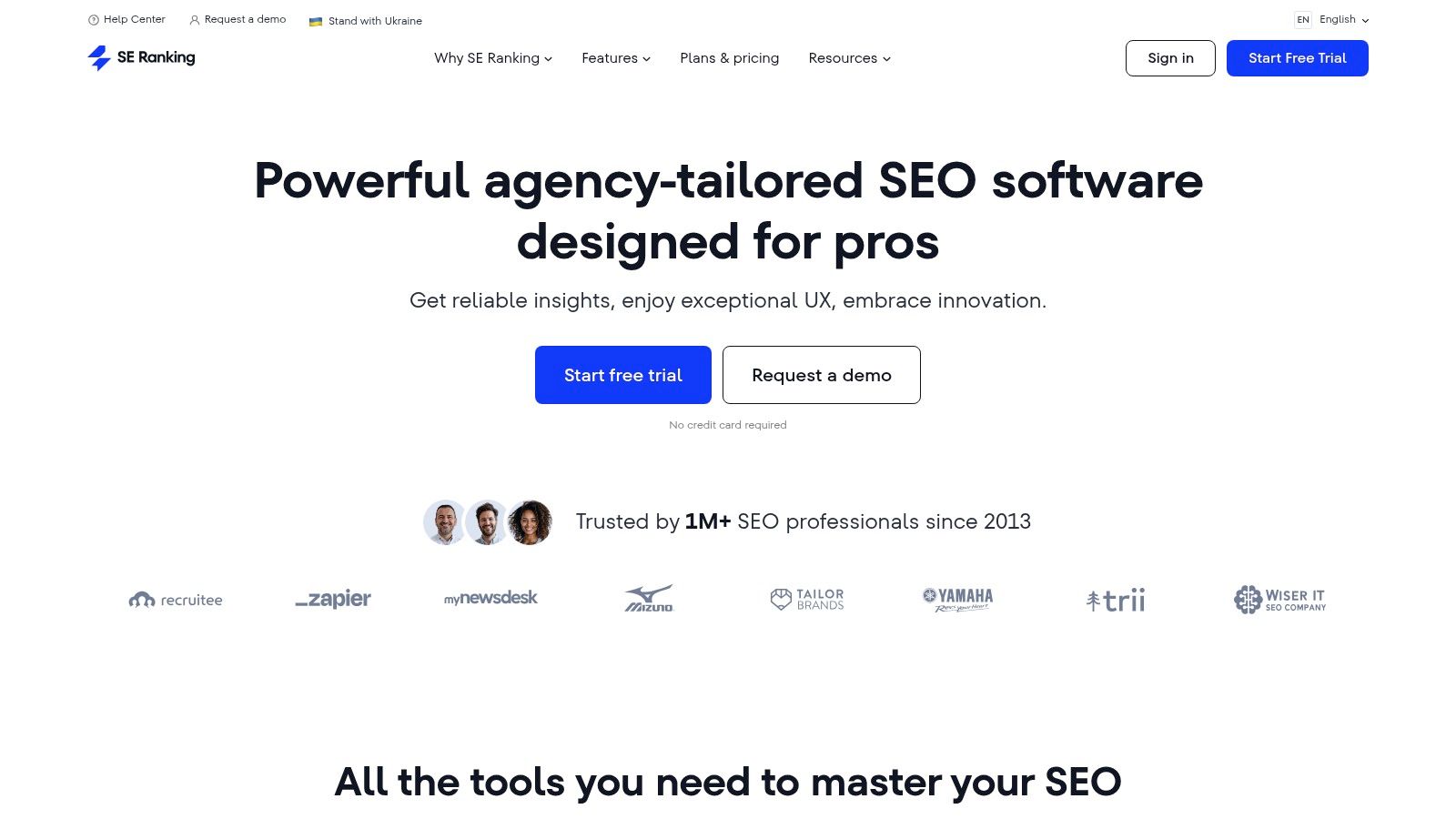
The platform’s core value lies in its integrated approach. You can track keyword rankings, audit your site, analyze competitor backlink profiles, and even research their paid ad strategies from a single, unified dashboard. This integration makes it one of the most efficient SEO competitor analysis tools for users who want to connect the dots between different data points without subscribing to multiple services.
Key Features & Use Cases
- Competitor Analysis Tool: This dedicated feature lets you directly compare your domain against competitors on metrics like domain trust, organic traffic, total keywords, and backlink counts. A common use case is to run a quarterly benchmark report to visualize your progress against key rivals.
- Backlink Checker: You can input a competitor's URL to get a detailed breakdown of their backlink profile. This is crucial for identifying high-authority domains your competitors are getting links from, providing a clear roadmap for your own link-building outreach.
- PPC Research: A standout feature at its price, this tool uncovers the keywords your competitors are bidding on in Google Ads and shows their ad copy. This is invaluable for identifying profitable keywords you might have missed in your organic strategy.
- Accurate Rank Tracking: SE Ranking provides daily keyword position updates across multiple search engines, including Google, Bing, and YouTube. You can tag keywords to segment campaigns, such as by "brand" or "high-intent," for more granular performance analysis.
Pricing & Implementation
SE Ranking’s pricing is flexible and scales based on the frequency of rank checking (daily, every 3 days, or weekly) and the number of keywords. Setup is intuitive: create a project, add your domain and competitors, and input your keywords.
- Essential: Starts at $55/month for 750 keywords.
- Pro: Starts at $109/month for 2,000 keywords and includes historical data.
- Business: Starts at $239/month for 5,000 keywords and advanced features.
Pros & Cons
Pros:
- Excellent value, offering a wide feature set for a competitive price.
- The user interface is clean and generally easy for beginners to navigate.
- Includes competitor PPC research, a feature often found in more expensive tools.
- Flexible pricing plans based on usage needs.
Cons:
- Backlink and traffic data can sometimes be less comprehensive than top-tier competitors.
- Lacks some of the advanced filtering and data-mining capabilities of enterprise-grade platforms.
- Limited native integrations with third-party marketing tools.
Website: https://seranking.com/
9. Serpstat
Serpstat positions itself as a growth-hacking tool, offering a robust, all-in-one SEO platform that is notably more affordable than some of its high-end competitors. It provides a comprehensive suite of features that cater to businesses and agencies looking for a powerful yet budget-friendly solution. Its strength lies in balancing functionality with cost, making advanced keyword research, backlink analysis, and site auditing accessible without the premium price tag.
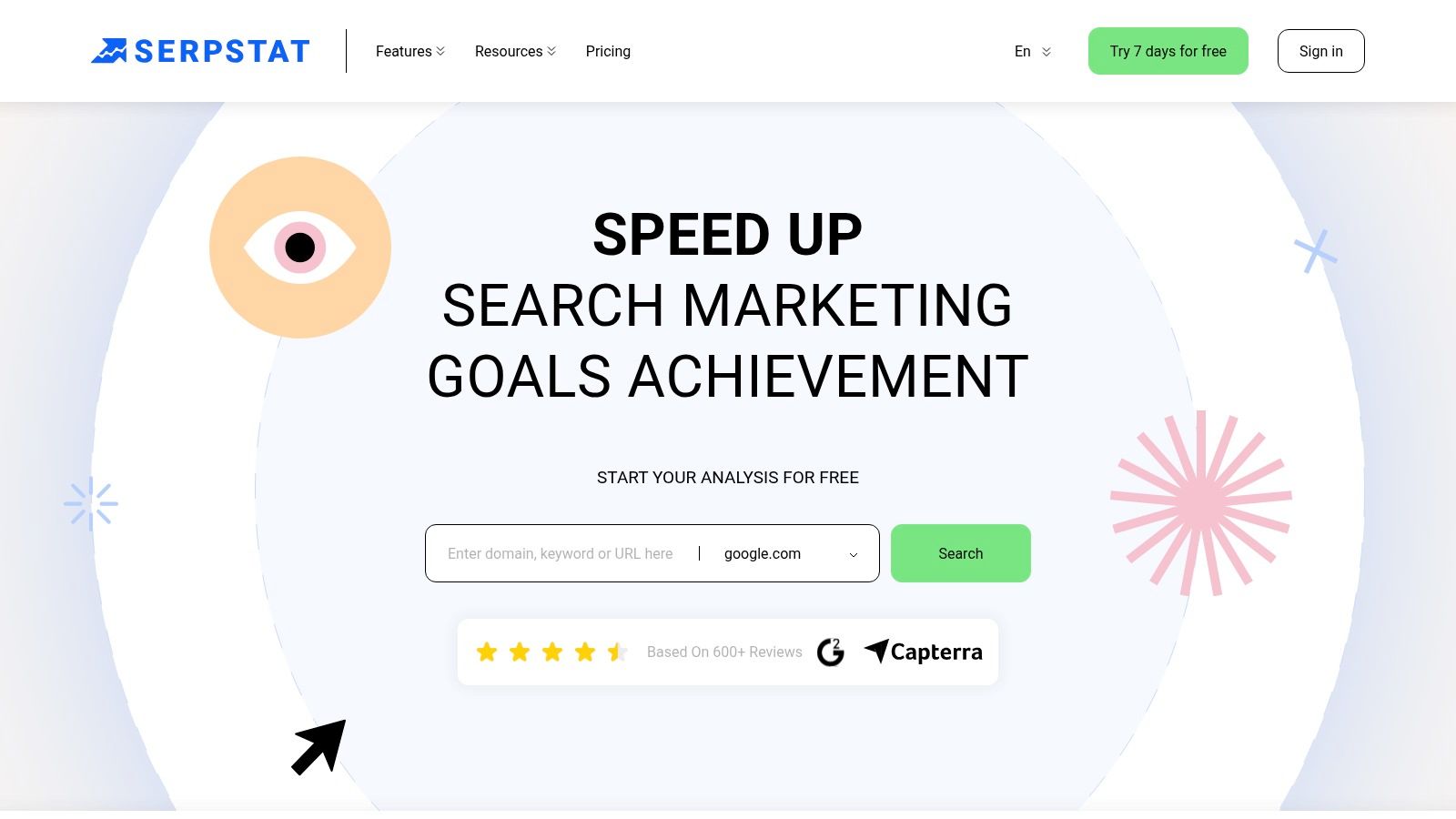
The platform is particularly useful for identifying content gaps and keyword opportunities. By entering a competitor’s domain, you can quickly see which keywords they rank for that you don't, providing an instant roadmap for new content creation. This makes Serpstat one of the most practical seo competitor analysis tools for marketers focused on outmaneuvering rivals in search results.
Key Features & Use Cases
- Competitor Analysis: The "Domain vs Domain" feature allows you to compare your site against two competitors side-by-side, revealing common and unique keywords. A great use case is analyzing the keyword overlap to find terms all three of you are targeting, indicating high-value industry topics.
- Keyword Research: Its "Missing Keywords" report is a standout feature. It shows you keywords for which your top 10 competitors rank, but you don't. This is perfect for discovering untapped keyword opportunities with proven traffic potential.
- Site Audit: The tool identifies technical SEO errors and categorizes them by severity. Small business owners can use this to quickly pinpoint critical issues like broken links or missing meta tags without needing deep technical knowledge.
- Rank Tracking: You can monitor keyword positions across different geographic locations and device types, which is essential for businesses with a local or international presence.
Pricing & Implementation
Serpstat offers a tiered pricing model that scales with your needs, from individual freelancers to large agencies. Getting started involves creating an account and setting up your first project by adding your domain.
- Individual Plan: Starts at $50/month for freelancers and startups.
- Team Plan: Starts at $112/month with more credits and multi-user access.
- Agency Plan: Starts at $375/month for large-scale operations.
Pros & Cons
Pros:
- Very competitive pricing for an all-in-one SEO toolset.
- Unique features like "Missing Keywords" and "Domain vs Domain" provide actionable competitive insights.
- The user interface is generally clean and easy to navigate.
- Regularly updated with new features and improvements.
Cons:
- The backlink and keyword databases, while substantial, can be smaller than those of top-tier competitors like Ahrefs or Semrush.
- Some advanced features may feel less polished or in-depth compared to more expensive platforms.
Website: https://serpstat.com/
10. Majestic
Majestic carves out its niche by focusing almost exclusively on one thing: backlinks. While platforms like Ahrefs and Semrush offer a broad suite of features, Majestic provides one of the most comprehensive backlink indexes on the market. Its proprietary metrics, Trust Flow and Citation Flow, have become industry-standard proxies for evaluating the quality and quantity of links pointing to a domain, making it an essential tool for deep-dive link profile analysis.

The platform is less of an all-in-one solution and more of a specialist’s instrument. For SEO professionals focused on link building or performing a link-based audit, Majestic offers a level of granularity that is hard to match. This specialization makes it a powerful component of any stack of SEO competitor analysis tools, especially when you need to understand precisely why a competitor's page is ranking based on its link authority.
Key Features & Use Cases
- Trust Flow & Citation Flow: These are Majestic's cornerstone metrics. A common use case is to vet potential link-building opportunities; a site with high Citation Flow but low Trust Flow might be spammy, whereas a balanced or high Trust Flow indicates a more authoritative source.
- Site Explorer: This core feature provides a complete overview of a domain's backlink profile. You can use it to quickly identify a competitor's most powerful links and uncover link-building strategies you can replicate.
- Backlink History: Analyzing a competitor's link acquisition velocity over time can reveal their campaign efforts. A sudden spike in new links might indicate a recent successful PR campaign or, conversely, a negative SEO attack.
- Comparative Analysis: The "Compare Tool" allows you to benchmark your backlink profile directly against several competitors. This is invaluable for visualizing link gap analysis and identifying common links you might be missing.
Pricing & Implementation
Majestic’s setup is simple for its core function: just enter a domain to start analyzing. The plans are structured around the volume of data and analysis units you need.
- Lite: $49.99/month for 1 million analysis units.
- Pro: $99.99/month for 20 million analysis units and more in-depth features.
Pros & Cons
Pros:
- Extensive and historically deep backlink index.
- Unique and respected metrics (Trust Flow/Citation Flow) for link quality assessment.
- Powerful tools for direct domain comparison and link gap analysis.
- Generally more affordable than all-in-one SEO suites for its specialized purpose.
Cons:
- Very limited functionality beyond backlink analysis; lacks keyword and content tools.
- The user interface can feel dated compared to more modern platforms.
- Some of its freshest backlink data can sometimes lag behind competitors like Ahrefs.
Website: https://majestic.com/
11. Ubersuggest
Ubersuggest, developed by Neil Patel, has carved out a niche as one of the most accessible and cost-effective SEO tools on the market. It's designed for beginners, small businesses, and solopreneurs who need robust functionality without the steep learning curve or high price tag of enterprise-level platforms. Its primary value lies in bundling essential features like keyword research, basic backlink analysis, and competitor traffic estimates into an incredibly user-friendly package.
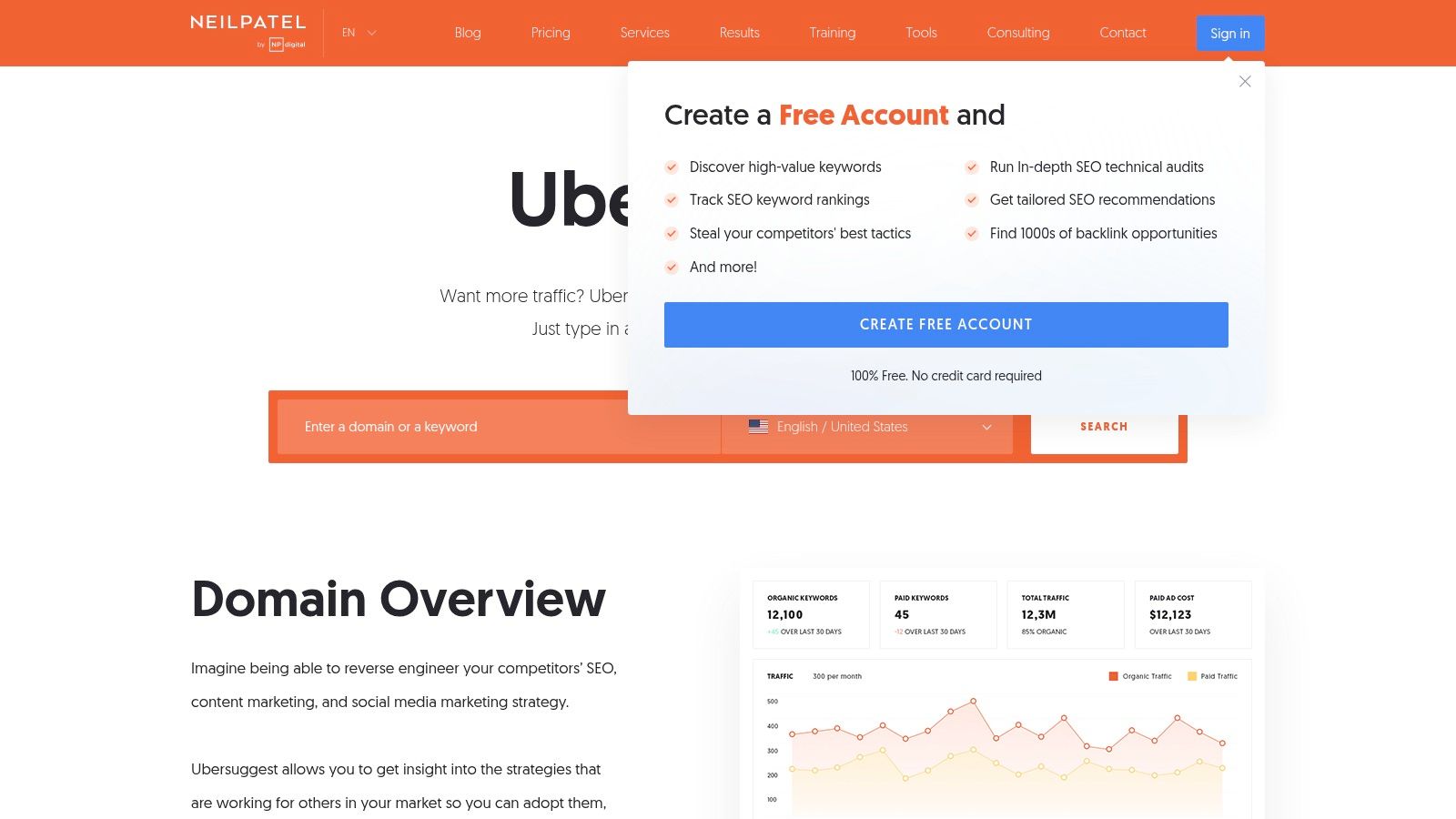
The platform excels at providing a quick, high-level overview. By simply entering a competitor's domain, you can instantly see their estimated organic traffic, top-performing keywords, and most valuable pages. This makes it an excellent starting point for anyone looking to understand a rival's strategy. While the data might not have the same depth as Ahrefs, it provides more than enough actionable insight for many users, making it a staple among budget-conscious seo competitor analysis tools.
Key Features & Use Cases
- Competitor Analysis: The "Top Pages by Traffic" report is a standout feature. A common use case is to enter a direct competitor's URL to identify their content that attracts the most organic search traffic. This allows you to reverse-engineer their success by creating superior content on the same topics.
- Keyword Suggestions: Its keyword research tool is great for brainstorming. You can input a seed keyword and get hundreds of related terms, questions, and prepositions, complete with search volume and difficulty scores. This is perfect for building out a content calendar.
- Site Audit: The audit tool scans your website for common SEO errors like broken links, slow page speed, and duplicate titles. It provides a simple health score and a prioritized list of fixes, ideal for non-technical users.
- Backlink Data: You can view a competitor's backlink profile to see who is linking to them. While not as comprehensive as specialized tools, it's useful for finding initial link-building opportunities.
Pricing & Implementation
Ubersuggest is known for its affordability, offering a limited free version and very competitive paid plans. Getting started involves creating an account and adding your project domain. The interface guides you through each feature, making it easy to jump right into analysis.
- Individual: $40/month
- Business: $60/month
- Enterprise: $100/month
Pros & Cons
Pros:
- Highly affordable, with a generous free plan for initial testing.
- Extremely user-friendly interface is perfect for SEO beginners.
- Provides a good all-around set of features for the price.
- Regularly updated with new features and improvements.
Cons:
- Data and metric accuracy can be less reliable than more expensive tools.
- Lacks the advanced filtering and in-depth analysis of premium platforms.
Website: https://neilpatel.com/ubersuggest/
12. Screaming Frog SEO Spider
Screaming Frog SEO Spider is a powerful desktop-based website crawler that has become an industry standard for technical SEO audits. While not a cloud platform, its strength lies in providing incredibly detailed, raw data about a website's architecture. For competitor analysis, it allows you to crawl a rival's entire site, giving you a complete blueprint of their on-page strategy, internal linking structure, and content hierarchy. This makes it one of the most granular seo competitor analysis tools for reverse-engineering a competitor's technical and on-page success.
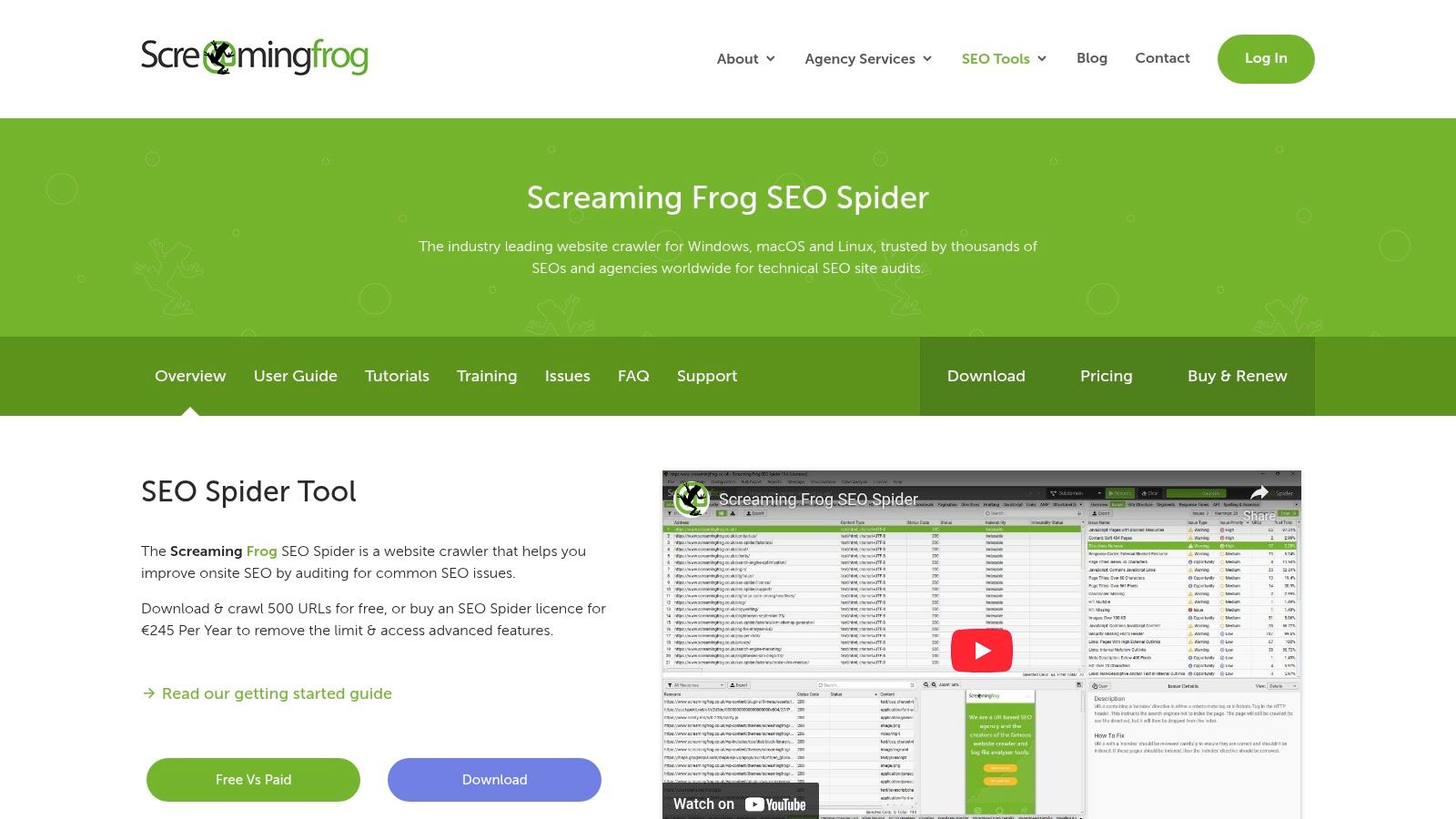
Unlike tools that present curated dashboards, Screaming Frog gives you the direct data feed. It’s the tool you use when you need to move beyond high-level metrics and understand exactly how a competitor has structured their site for search engines. This makes it indispensable for SEO professionals who need to perform deep-dive technical comparisons.
Key Features & Use Cases
- Site Crawling: The core function lets you crawl a competitor's site to extract all URLs, page titles, meta descriptions, headings (H1s, H2s), and more. A common use case is exporting this data to a spreadsheet to identify how a competitor targets specific keyword clusters across their content.
- Broken Link Detection: Crawl a competitor's domain to find their broken internal and external links. This presents a "broken link building" opportunity, where you can contact the sites linking to their dead pages and suggest your relevant content as a replacement.
- Internal Linking Analysis: Analyze how your competitors pass authority through their site. You can identify their most-linked-to internal pages, revealing what content they deem most important and want to rank highest.
- XML Sitemap Generation: While you'd use this for your own site, you can also analyze a competitor's sitemap to quickly see which pages they consider important enough to submit to Google for indexing.
Pricing & Implementation
As a desktop application, you simply download and install the software on your Mac, Windows, or Ubuntu machine. The free version is quite capable for smaller sites or quick checks.
- Free Version: Crawl up to 500 URLs. Access to most, but not all, features.
- Paid Licence: £259/year per user for unlimited crawls and access to advanced features like Google Analytics integration, custom extractions, and scheduling.
Pros & Cons
Pros:
- Provides exhaustive technical and on-page SEO data.
- Excellent for identifying a competitor's site structure and content strategy.
- The free version is highly functional for auditing smaller competitor sites.
- Regularly updated with new features and integrations.
Cons:
- Requires technical knowledge to interpret the vast amount of data effectively.
- Being a desktop application, it uses your local computer's resources.
- The user interface can be intimidating for beginners.
Website: https://www.screamingfrog.co.uk/seo-spider/
SEO Competitor Analysis Tools Comparison
| Tool | Core Features & Unique Selling Points | User Experience & Quality ★ | Value Proposition 💰 | Target Audience 👥 | Price Points 💰 |
|---|---|---|---|---|---|
| That's Rank 🏆 | Daily Google rank tracking, unlimited domains, SEO audits ✨ | Simple, intuitive, accurate ★★★★ | Free plan + scalable Pro plans 💰 | Bloggers, agencies, e-com stores 👥 | Free to $29/month 💰 |
| SEMrush | All-in-1 SEO, PPC, social media insights, huge keyword DB ✨ | Intuitive but steep learning ★★★ | Comprehensive but pricey 💰 | Digital marketers, agencies 👥 | Higher-tier pricing 💰 |
| Ahrefs | Top backlink & keyword data, Site Explorer & audits ✨ | Actionable insights, user-friendly ★★★★ | Premium tool with constant updates 💰 | SEO pros, agencies 👥 | High cost 💰 |
| Moz Pro | Domain Authority, on-page grader, site crawl ✨ | Beginner-friendly, strong community ★★★ | Mid-high pricing with good support 💰 | Beginners, SMBs 👥 | Medium to high 💰 |
| SpyFu | Competitor keyword & PPC analysis, historical data ✨ | Easy to use, focused on PPC/SEO ★★★ | Affordable with valuable competitor data 💰 | SMBs, PPC marketers 👥 | Moderate, affordable 💰 |
| SimilarWeb | Traffic & audience insights, engagement & benchmarks ✨ | Visual, user-friendly ★★★ | Best for market research, not SEO focused 💰 | Market researchers, analysts 👥 | Variable, paid plans 💰 |
| BuzzSumo | Content & influencer analysis, trend tracking ✨ | User-friendly & insightful ★★★ | Content marketing focused, higher cost 💰 | Content marketers, PR 👥 | Premium pricing 💰 |
| SE Ranking | Keyword rank tracking, backlink checker, audits ✨ | Beginner-friendly, accurate ★★★ | Affordable with solid SEO features 💰 | Beginners, SMBs 👥 | Affordable 💰 |
| Serpstat | All-in-1 SEO: keywords, backlinks, site audits ✨ | User-friendly, regular updates ★★★ | Cost-effective, good for businesses 💰 | SMBs, growing businesses 👥 | Affordable 💰 |
| Majestic | Deep backlink analysis, Trust Flow metrics ✨ | Simple interface, backlink focused ★★★ | Specialist tool, limited breadth 💰 | Link builders, SEO pros 👥 | Moderate 💰 |
| Ubersuggest | Keyword ideas, competitor analysis, site audit ✨ | Easy to use, good for beginners ★★★ | Low cost, basic data depth 💰 | Beginners, small businesses 👥 | Low cost 💰 |
| Screaming Frog SEO Spider | Desktop crawler, site audit, broken links, sitemaps ✨ | Powerful but technical ★★★ | One-time cost, requires SEO knowledge 💰 | SEO professionals, auditors 👥 | Free & paid versions 💰 |
Final Thoughts
Navigating the landscape of seo competitor analysis tools can feel like charting unknown territory. We've journeyed through a comprehensive list, from all-in-one powerhouses like Ahrefs and SEMrush to specialized instruments like Majestic for backlink intelligence and BuzzSumo for content strategy. Each tool offers a unique lens through which to view your competition, revealing the strategies that fuel their success and the opportunities they've missed.
The core takeaway is this: competitor analysis is not a one-time task but an ongoing strategic process. The digital marketplace is in constant flux, with algorithms updating, new competitors emerging, and consumer behavior shifting. The right tool acts as your compass, providing the data needed to adapt, innovate, and ultimately, outperform.
Choosing Your Toolkit: A Needs-Based Approach
Selecting the perfect tool from this extensive list depends entirely on your specific context, resources, and goals. There is no single "best" option for everyone. Let's distill the decision-making process into a few key scenarios:
- For the All-In-One Strategist (Agencies & In-House Teams): If you require a comprehensive suite that covers everything from keyword gaps and backlink analysis to content ideation and rank tracking, your best bets are SEMrush, Ahrefs, or Moz Pro. These platforms are the Swiss Army knives of SEO, providing a robust, integrated solution for managing complex campaigns across multiple clients or business units. Their higher price point is justified by the sheer breadth of functionality.
- For the Budget-Conscious Practitioner (Small Businesses & Freelancers): When every dollar counts, you need maximum impact for minimal investment. SE Ranking and Serpstat offer a remarkable balance of features and affordability, providing powerful competitive insights without the enterprise-level price tag. Ubersuggest also stands out as a highly accessible entry point, perfect for those just beginning their SEO journey.
- For the Niche Specialist: Sometimes, you need a tool that does one thing exceptionally well.
- Backlink Analysts will find unparalleled depth in Majestic's historical index.
- Content Marketers will gain a significant edge by using BuzzSumo to dissect top-performing content.
- Technical SEOs will rely on the granular data uncovered by Screaming Frog SEO Spider to diagnose on-page and architectural issues.
Implementation: From Data to Action
Acquiring a tool is only the first step; the real value lies in its implementation. To turn raw data into a tangible competitive advantage, focus on creating a repeatable process:
- Establish a Baseline: Before you dive deep into competitor data, understand your own performance. Track your core keywords, top pages, and backlink profile.
- Define Your True Competitors: Look beyond the obvious names. Use the tools to identify who is actually ranking for your target keywords, as these are your true "search competitors."
- Schedule Regular Audits: Set a recurring calendar reminder (monthly or quarterly) to perform a competitive analysis. Consistency is key to spotting trends and reacting quickly.
- Focus on Actionable Insights: Don't get lost in vanity metrics. Ask "So what?" for every piece of data. If a competitor has 50 new backlinks, the actionable insight is to analyze those links and see if you can replicate their strategy.
Ultimately, the goal of using seo competitor analysis tools is not to simply copy your rivals but to understand their playbook so you can write a better one. By identifying their strengths, you can match them. By pinpointing their weaknesses, you can exploit them. This continuous cycle of analysis, insight, and action is the engine of sustainable growth in the competitive world of search engine optimization.
Ready to simplify your competitive analysis and focus on what truly matters? For a streamlined, user-friendly approach that delivers actionable rank tracking and SERP analysis without the overwhelming complexity, explore That's Rank. It's designed to give you the precise competitive insights you need to make smarter SEO decisions, faster.